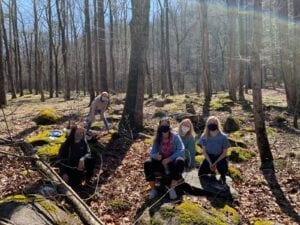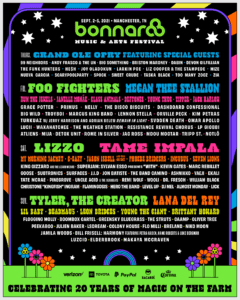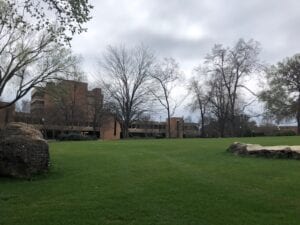Vietnamese communities create their own world in time of anti-immigration policy


Entering Sapa Marketplace, one might find them self feeling as if they have stepped into Vietnam itself. While surveying the landscape, the only places visible nearby the outskirts of the marketplace are a few apartment complexes.
The Vietnamese are among the largest immigrant populations in the Czech Republic. Even though they make up such a large portion of the population, they are often overlooked and pushed to the side more than other ethnic groups.
Sapa is located on the outskirts of Prague and can be accessed by taking the 197 bus clear to the end of the line. Upon exiting the bus, it can be disorienting to see this deserted area of town.
The Sapa marketplace is its own community. Following the Dong Do restaurant, a series of tents and strip mall-like shops line the dirt road that inches further into the center of the market.
The market, Little Hanoi, is a haven for Vietnamese immigrants. Tourists might get the sense that they are an outsider as many people working in the market speak strictly Vietnamese or have no interest in interacting with non-Vietnamese people.
Han Nguyen, a Vietnamese student at Charles University, believes this stereotype of “Vietnamese vendors” was originally created due to past generations of Vietnamese immigrants not being fluent in Czech. Nguyen further explained that when the Czech Republic was still a communist country, the Vietnamese were actually invited to work there for a limited time. Additionally, some of the workers ended up staying in the Czech Republic, including Nguyen’s mother.
“She came back several times, but she was never able to stay due to the poor living conditions. Even though now everything has improved tremendously, people still thrive for a better life elsewhere,” Nguyen said. “If they have the chance, young students often move out of the country to study at a foreign university. Some of them come back; some of them swear to never live there again.”
Nguyen further elaborated that students who return to Vietnam do so because they know they have something to return to:
“In Vietnam, having connections is the key to everything, in a very literal sense. Those students that come back don’t have to find a job. Their parents have already prepared that for them,” Nguyen said. “Having skills or being gifted means absolutely nothing if you don’t have connections, very very literally.”
Districts like Little Hanoi help to create a sense of community among certain groups that are discounted or otherwise ignored in a larger society. Prime Minister of the Czech Republic Andrej Babis has created an atmosphere of anti-immigration. Babis has even stated that immigration was the cause for the 2016 Berlin attack where a truck was driven into a Christmas Market, killing 12 people and injuring 56.
“Unfortunately … [Angela Merkel’s “open-door” migration] policy is responsible for this dreadful act,” Babis said. “It was she who let migrants enter Germany and the whole of Europe in uncontrolled waves, without papers, therefore without knowing who they really are.”
This sentiment is not held by the Czech Republic alone as United States President Donald Trump rode a similar ideology straight into office. Many countries are starting to crack down on their borders to curb immigration in recent years.
According to this article, since 2001, the Czech Republic has seen a major growth in the number of migrants from abroad as it started at roughly 25,000 per year and grew to approximately 100,000 in 2007. The article further examines the history of how immigration came to be so big in the Czech Republic:
“With the democratic transformation and the Velvet Divorce from Slovakia after 1989, the Czech Republic shifted from being a country of emigration, to a transit country, and then to a country of immigration.”
The Czech Republic has become quite a hot spot for immigration which has polarized its citizens. This has controversially led to Babis being elected as the country’s Prime Minister, mirroring the aforementioned rise to power of Trump.
The movement against immigrants in the Czech Republic has forced groups such as the Vietnamese into forming their own communities. These groups can become isolated from other societies, which can cause a more two-sided divide. In other words, some immigrants learn to be weary of outsiders in their own communities.
If one were to pull out a phone and start snapping pictures in Sapa market, they would, in all likelihood, attract negative attention. This distrust may be a product of how these minority groups are treated by their society or how these groups have no desire to fit into society.
“I have to say that the issue that angers me the most is how old-fashioned some of the Vietnamese are. Some of the older people don’t understand that their way of raising children or their way of handling things is just not what is acceptable here,” Nguyen said. “It is frustrating that they are trying to find a better life somewhere else and yet, bring the worst of the culture with them. Mainly their disrespect towards women, children and rules. Vietnamese children of such people grow up dealing with psychological scars and issues all their life, most of them develop depression and anxiety.”
No matter the reason, small communities like the one found in Little Hanoi are often quite isolated from the center of society both physically and culturally. It’s hard to say if it would be beneficial for these cultures and the native society to find a common ground or if this divide is just an unavoidable side effect of immigration.
Written by Alex Sherry
Featured image courtesy of tasteofprague.com
Edited by Ciera Noe



